You may have noticed a small drain line near the indoor unit if you have a central air conditioning system. This drain line is known as the condensate drain and plays a vital role in the proper functioning of your air conditioning system.
But what happens if you notice air coming out of the condensate drain line? Is this normal, or is it a sign of a problem?
In this post, we will explore the purpose of the condensate drain line and discuss the potential causes and consequences of air coming out of it.
It is generally not normal for air to be coming out of the condensate drain line of a central air conditioning system.
The condensate drain line is designed to carry excess moisture away from the air conditioning system, so air should not be in the drain line.
If you notice air coming out of the condensate drain line, it could be a sign of a problem with your air conditioning system.
Some potential causes of air in the condensate drain line include a clogged drain line, a faulty condensate pump, or a problem with the air conditioning unit itself.
If you are experiencing this issue, it is recommended that you contact a licensed HVAC technician to diagnose and resolve the problem.
Ignoring this issue could lead to further damage to your air conditioning system or even flooding your home.
Should Air Be Coming Out Of My Condensate Drain Line?
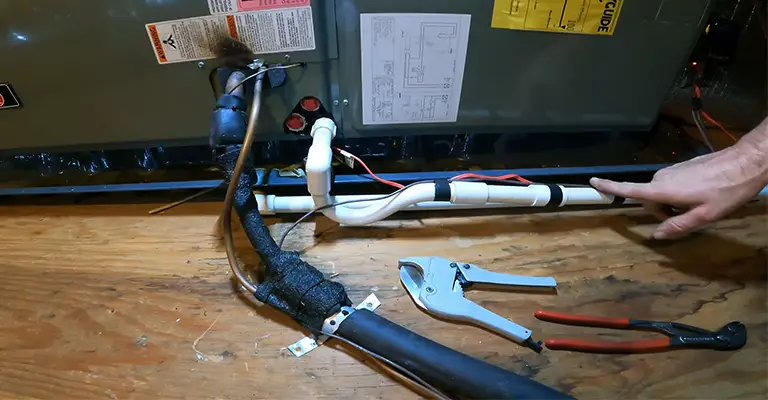
You’ll usually find traps in the condensate drain line of your air conditioner to control airflow into and out of the handler. Would this mean that air should escape from the condensate drain line?
Despite its role as a vent for air, your AC drain line should not emit forced air. If this is the case, you may have clogging issues with your condensate drain line.
In the long run, this will reduce the efficiency of your AC and may lead to system damage. It is important to know how your condensate drain line should operate.
The trap must function properly to prevent overflow and other problems. Discover how to prevent these problems and what to do when you experience them by reading on.
What Happens When Condensate Drain Line Clogs?
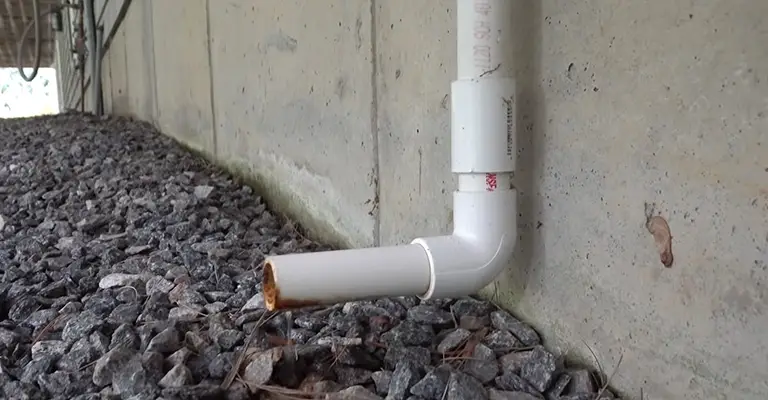
When your drain line clogs, your air conditioner cannot release condensate water, leaving it in the drain pan or inside your drain pipe.
Corrosion or rust can occur on metal parts in contact with water if condensate remains stuck in the drain line.
If you do not take proper care of your system, it could shorten its lifespan and result in costly repairs.
As a result, water will remain stagnant as long as your air conditioner is running, as it can’t pass through. You may need to make excessive repairs, replace your entire system, or even incur major damages in this instance.
A condensate drain pan that evaporates water increases humidity levels in your home.
Besides causing uncomfortable and sticky air, it also leads to mold and mildew growth, which damages property. Furthermore, it can cause health complications.
Is My AC Drain Line Clogged?
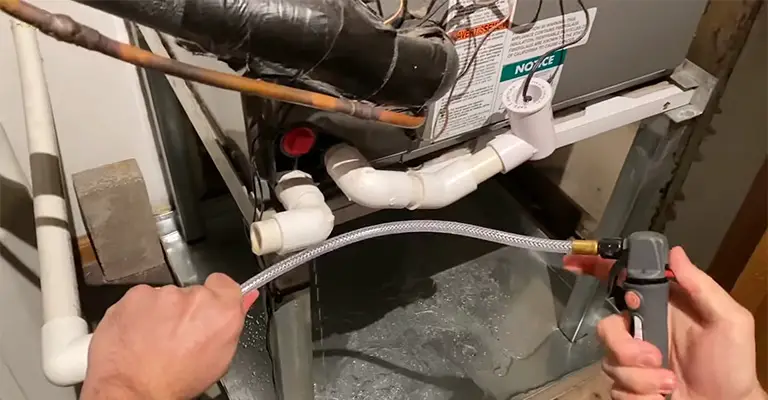
Usually, when air comes out of your drain line, it is clogged. During system operation, a condensate drain line is a funnel for air to enter and exit.
A condensate pan is fitted with traps that keep air from coming through and allow water to drain. As a result, moisture doesn’t accumulate around the ductwork and insulation, which results in less damage.
A clogged drain line can compromise your system’s or your home’s performance, so be on the lookout for different symptoms that indicate a possible obstruction.
Clogging can be indicated by a few signs other than the air coming out of your drain line:
- An unpleasant odor comes from dampness or mold.
- A malfunctioning air conditioner shuts down or fails to turn on.
- The water in your air conditioner drips excessively.
- Cooling your home is a challenge for your air conditioner.
Can I Unclog My Air Conditioner Drain Line?
You can do it yourself if you want to unclog your AC drain line. Before doing so, you should use condensate line cleaners designed for this purpose. Using bleach or other household cleaners is never a good idea.
The use of vinegar and water solution is sometimes recommended, but it should be avoided unless you have no other options available. These corrosive chemicals can damage a coil’s evaporator.
How To Check For AC Drain Lines?
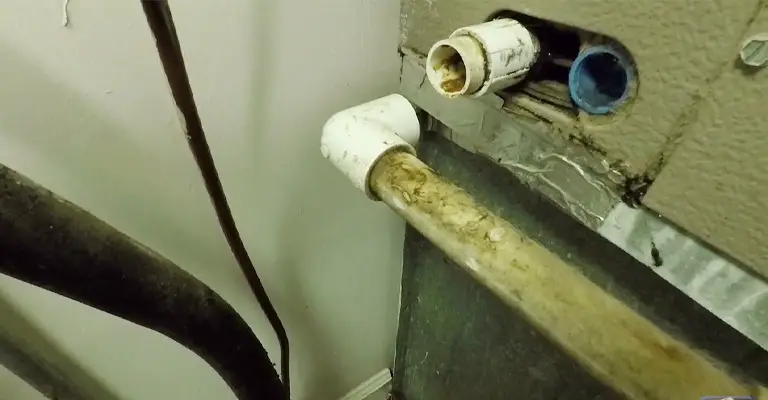
To ensure that your drain lines remain in good working condition, check them regularly. These are a few ways to inspect the condensate drain line:
Condensate Line Drainage
To ensure your system is working properly, your condensate drain line should drip water. If it doesn’t drain any water, clogs or installation issues are preventing it from doing so.
However, be sure to check where your system leaks water. You shouldn’t be experiencing this issue anywhere but in your drain line.
Drain Pan Capacity
Full drain pans can result from clogged condensate drain lines. To ensure the pan is not overflowing, check it for fullness.
It is important to clean your drain line as soon as possible if this is the case to prevent possible damage to your HVAC system.
Air Conditioning Unit Functionality
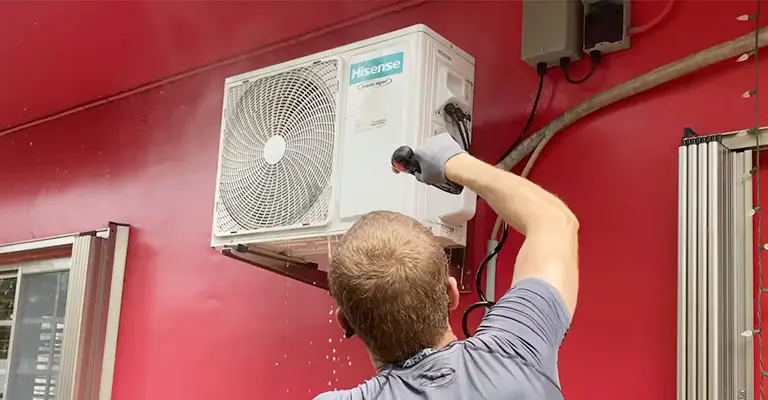
You use your air conditioner to control humidity levels and create comfort in your home. A cooling system accomplishes this.
A problem with the drain system could cause your AC to fail to cool. A safety switch that shuts off the power in case of overflow or water damage is commonly found in some units.
How To Unclog A Condensate Drain Line?
The following steps will help you unclog your condensate drain:
1. Turn Off Your AC
To prevent shock or damage to your air conditioner, you should also turn off the device’s switch on the circuit breaker panel.
2. Locate The Pipe
There are usually three places to find it: outdoors, near the condenser unit, or in the furnace room. You can refer to a PVC pipe as an example.
3. Take Off The Cap
Your condensate drain line already comes with a drain cap. In this case, you can pull it off easily.
4. Check For Any Debris Stuck Inside
Ensure that the drain line is free of debris and dirt by thoroughly inspecting it. This could cause a clogged drain.
5. Remove Visible Debris And Retest
Do this carefully so that you don’t push it down the drain line any further. Make sure there is as much space as possible.
6. Pour In Your Cleaner
Place a cup of your chosen cleaner inside the pipe and slowly pour it in.
7. Replace The Cap
Then turn on the air conditioner after waiting half an hour.
Using a wet/dry vacuum can help clear clogging that has built up in your drain line if you haven’t cleaned it for a while. Using the vacuum on the pipe after unscrewing the cap will help remove debris and trapped water.
A licensed professional should be contacted if there is a more complex clogging or if the issue has already resulted in further damage. A severe clog may require you to replace the drain line, which is the worst-case scenario.
How Much Water Should My AC Drain?
It is not always an indication of a problem when water comes out of your air conditioner. Due to the cold temperature of the coils, the air handler inside your HVAC system condenses water during operation.
Afterward, the water falls into the drain pan, traverses the drain line, and exits your property.
The amount of water your air conditioner eliminates is normal, but you should determine how much water is being lost. A clogged drain line indicates that your drain isn’t draining or draining too much.
How To Keep Your AC Drain Line From Issues?
You can prevent clogging problems in your system by following several strategies. Take a look at these helpful tips and practices:
Have It Checked Routinely
Scheduling maintenance can help you keep an eye on your condensate drain system if you don’t have time or easy access to the unit.
In addition to their service packages, HVAC professionals typically inspect condensate drainage systems as part of their services. The company can also assist with the request for additional measures to inhibit mold growth.
Always Keep Your Drain Line Clear
Overflow and clogging can be prevented by regularly clearing or flushing your drain line. You need to run clean water through the pipe and find it.
If dirt buildup is present, you can also add a cleaning mixture to remove the dirt before it grows. Before applying these solutions, make sure you use the appropriate cleaning solutions.
Understand The Consequences Of Mismanaged Condensate
Most homeowners are scared of the consequences of poorly managing dark and humid areas around their homes. All the condensation usually results in the growth of bacteria.
It is common for drain systems to develop these problems due to the generation of condensation by air conditioning coils. Drain pans and lines can cause the pooling of water in the AC system if they are not properly installed or maintained.
There is a high risk of mold accumulation, clogging, overflow, and corrosion within a system when this occurs.
Know Where Your Drain System Goes
It is important to know the location of your condensate drain system to prevent further damage.
System configurations may differ with different air conditioners. A drain line could be difficult to find on some models, making troubleshooting even more challenging.
Managing your condensate drain system and fixing any problems will be easy once you know how to get to it.
Final Words
In conclusion, it is generally not normal for air to be coming out of the condensate drain line of a central air conditioning system.
The air in the drain line could be a sign of a problem with the system, such as a clogged drain line, a faulty condensate pump, or an issue with the air conditioning unit itself.
If you notice air coming out of the condensate drain line, it is recommended that you contact a licensed HVAC technician to diagnose and resolve the problem.
Ignoring this issue could lead to further damage to your air conditioning system or even flooding your home.
Properly maintaining and troubleshooting your air conditioning system can ensure that it operates safely and efficiently.







